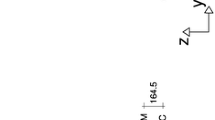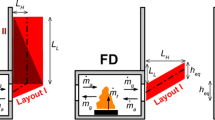Abstract
In this paper, the fire hazard and flame spread characteristics of vertical U-shape channel (asymmetric U-shape geometry) façade were investigated experimentally. A theoretical model for the flame spread and air entrainment mechanisms was also provided. It was found that the flame height, flame spread rate, and mass loss rate (MLR) increased with the increasing geometrical factor (dimensionless depth). And a limit was reached when the geometrical factor increased. Data indicated that the fire hazard of U-shape geometry was significantly higher than that of flat shape. For asymmetric factors (dimensionless asymmetric variances), the flame spread rate, flame height, and MLR decreased with the increasing asymmetric factor. Moreover, the theoretical model showed that flame spread rate increased with geometrical factor and decreased with asymmetric factor. Also, induced flow speed reached a limit with the increasing geometrical factor. Theoretical analysis agreed well with experiments. Model predictions of flame spread rate were reasonable and in the same order of magnitude as experiments. Theoretical analysis showed that flat-shape, L-shape, and symmetric U-shape geometries could be regarded as special cases of asymmetric geometries. The results of this study could be used for fire safety evaluations of vertical surface structure designs such as building façade and wall design.














Similar content being viewed by others
References
Lie TT. Contribution of insulation in cavity walls to propagation of fire. Fire Stud. 1972;29:15.
An W. Investigation of combustion and flame spread behaviors of ps insulation materials applying to building exterior wall [Doctor]. Hefei, China: University of Science and Technology of China; 2015.
Tsai K-C. Upward flame spread on a flat surface, in a corner and between two parallel surfaces. J Chin Soc Mech Eng. 2007;28(3):341–8.
Tsai K-C. Width effect on upward flame spread. Fire Saf J. 2009;44(7):962–7. https://doi.org/10.1016/j.firesaf.2009.06.003.
Tsai K-C. Influence of sidewalls on width effects of upward flame spread. Fire Saf J. 2011;46(5):294–304. https://doi.org/10.1016/j.firesaf.2011.03.006.
Tsai K-C, Wan F-S. Upward flame spread: The width effect. 8th International Symposium on Fire Safety Science, September 18, 2005 - September 23, 2005; 2005; Beijing, China: Interscience Communications Ltd.
Shih H-Y, Wu H-C. An experimental study of upward flame spread and interactions over multiple solid fuels. J Fire Sci. 2008;26(5):435–53. https://doi.org/10.1177/0734904108092547.
Hsin-Yi S. Flame spread and interactions in an array of thin solids in low-speed concurrent flows. Combust Theor Model. 2009;13(3):443–59. https://doi.org/10.1080/13647830902807314.
Xu T, He Q, Tang F, Lei P, Pang H. Experimental study on the vertical temperature distribution of window ejected fire from an enclosure with adjacent side walls. Fire Mater. 2020;44(1):152–62. https://doi.org/10.1002/fam.2787.
An W, Pan R, Meng Q, Zhu H. Experimental study on downward flame spread characteristics under the influence of parallel curtain wall. Appl Therm Eng. 2018;128:297–305. https://doi.org/10.1016/j.applthermaleng.2017.08.174.
An W, Sun J, Liew KM, Zhu G. Flammability and safety design of thermal insulation materials comprising PS foams and fire barrier materials. Mater Des. 2016;99:500–8. https://doi.org/10.1016/j.matdes.2016.03.080.
An W, Wang Z, Xiao H, Sun J, Liew KM. Thermal and fire risk analysis of typical insulation material in a high elevation area: Influence of sidewalls, dimension and pressure. Energy Convers Manage. 2014;88:516–24. https://doi.org/10.1016/j.enconman.2014.08.026.
Liang CJ, Cheng XD, Li KY, Yang H, Zhang HP, Yuen KK. Experimental study on flame spread behavior along poly(methyl methacrylate) corner walls at different altitudes. J Fire Sci. 2014;32(1):84–96. https://doi.org/10.1177/0734904113498848.
Tang F, Hu LH, Qiu ZW, Zhang XC, Lu KH. Window ejected flame height and heat flux along facade with air entrainment constraint by a sloping facing wall. Fire Saf J. 2015;71:248–56. https://doi.org/10.1016/j.firesaf.2014.11.023.
Jiang L, He J-J, Sun J-H. Sample width and thickness effects on upward flame spread over PMMA surface. J Hazard Mater. 2018;342:114–20. https://doi.org/10.1016/j.jhazmat.2017.08.022.
Hu LH, Lu KH, Tang F, Delichatsios M, He LH. A global non-dimensional factor characterizing side wall constraint effect on facade flame entrainment and flame height from opening of compartment fires. Int J Heat Mass Transf. 2014;75:122–9. https://doi.org/10.1016/j.ijheatmasstransfer.2014.03.059.
Lu KH, Hu LH, Tang F, He LH, Zhang XC, Qiu ZW. Experimental investigation on window ejected facade flame heights with different constraint side wall lengths and global correlation. Int J Heat Mass Transf. 2014;78:17–24. https://doi.org/10.1016/j.ijheatmasstransfer.2014.06.060.
Lu KH, Hu LH, Tang F, He LH, Zhang XC, Qiu ZW. Heat flux profile upon building facade with side walls due to window ejected fire plume: An experimental investigation and global correlation. Fire Saf J. 2014;70:14–22. https://doi.org/10.1016/j.firesaf.2014.08.001.
Ma X, Tu R, An W, Xu L, Luo S, Wang J, et al. Experimental study of interlayer effect induced by building facade curtain wall on downward flame spread behavior of polyurethane. Appl Therm Eng. 2020. https://doi.org/10.1016/j.applthermaleng.2019.114694.
Yan W, Shen Y, An W, Jiang L, Sun J. Experimental study on fire risk of buildings’ U-shaped exterior wall on flame propagation of insulation material on plain and plateau. J Fire Sci. 2015;33(5):358–73. https://doi.org/10.1177/0734904115596181.
Yan W, Shen Y, Jiang L, an W, Zhou Y, Li Z et al. Experimental study of sidewall and pressure effect on vertical downward flame spread over insulation material. The 10th Asia-Oceania Symposium on Fire Science and Technology; Tsukuba, Japan2015.
Yan W, Jiang L, An W, Zhou Y, Sun J. Large scale experimental study on the fire hazard of buildings’ U-shape façade wall geometry. J Civ Eng Manag. 2017;23(4):455–63. https://doi.org/10.3846/13923730.2016.1210671.
Li J, Yan W, Zhu H, Wang Q, Sun J. Experimental study on the fire spread in high-rise buildings with U-shaped outside-facade structure. Fire Saf Sci. 2012;21(04):167–73.
Li J, Yan W, Zhu H, Wang Q, Sun J. Numerical simulation on the fire spread in high-rise buildings with U-shaped outside-facade structure. Fire Saf Sci. 2012;21(04):174–80.
Yan W, Wang C, Guo J. One Extended OTSU flame Image recognition Method Using RGBL and Stripe segmentation. In: Sun D, Sung WP, Chen R, editors. Frontiers of Manufacturing and Design Science Ii, Pts 1–6. Applied Mechanics and Materials. Stafa-Zurich: Trans Tech Publications Ltd; 2012. p. 2141–5.
Heskestad G. Luminous heights of turbulent diffusion flames. Fire Saf J. 1983;5(2):103–8. https://doi.org/10.1016/0379-7112(83)90002-4.
Williams FA. Combustion Theory: The Fundamental Theory of Chemically Reacting Flow Systems. Perseus Books Group; 1985.
De Ris JN. Spread of a laminar diffusion flame. Symposium (International) on Combustion. 1969;12(1):241–52.https://doi.org/10.1016/S0082-0784(69)80407-8.
Bhattacharjee S, Wakai K, Takahashi S. Predictions of a critical fuel thickness for flame extinction in a quiescent microgravity environment. Combust Flame. 2003;132(3):523–32. https://doi.org/10.1016/S0010-2180(02)00501-1.
Mamourian M, Esfahani JA, Ayani MB. Experimental and scale up study of the flame spread over the PMMA sheets. Therm Sci. 2009;13(1):79–88. https://doi.org/10.2298/tsci0901079m.
Walton WD, Twilley WH. Heat Release and Mass Loss Rate Measurements for Selected Materials. NIST Interagency/Internal Report (NISTIR): NIST1984.
Author information
Authors and Affiliations
Corresponding author
Additional information
Publisher's Note
Springer Nature remains neutral with regard to jurisdictional claims in published maps and institutional affiliations.
Rights and permissions
About this article
Cite this article
Yan, W., Li, J., Shen, Y. et al. Experimental investigations on the flame spread of building’s vertical U-shape façade. J Therm Anal Calorim 147, 5961–5971 (2022). https://doi.org/10.1007/s10973-021-10926-9
Received:
Accepted:
Published:
Issue Date:
DOI: https://doi.org/10.1007/s10973-021-10926-9




